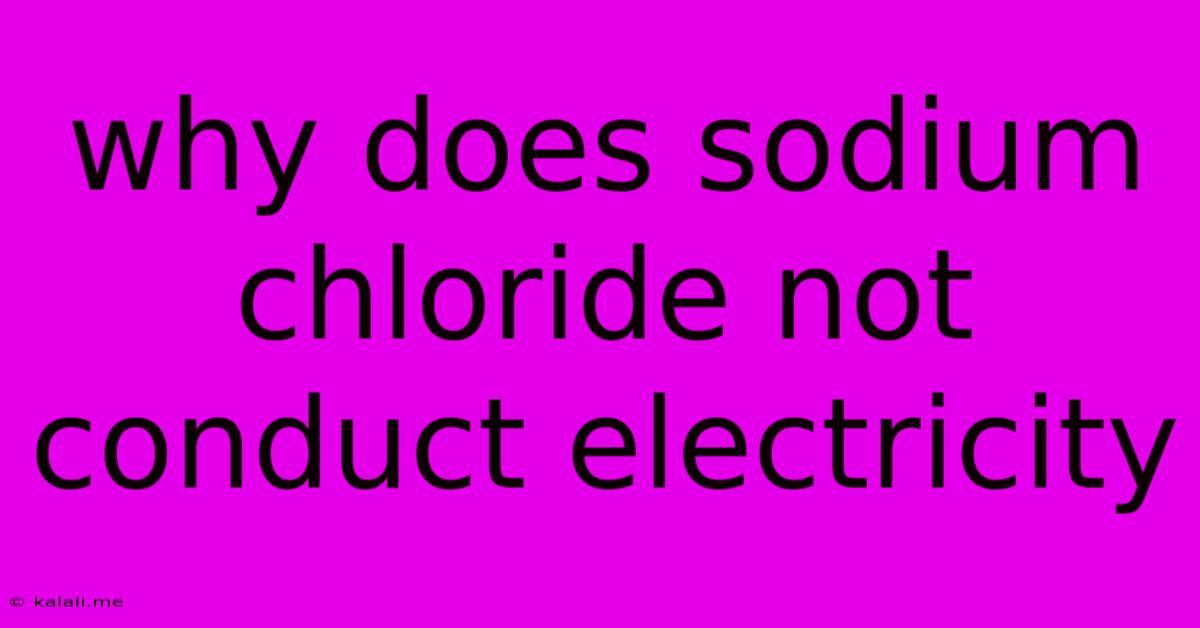Why Does Sodium Chloride Not Conduct Electricity
Kalali
May 22, 2025 · 2 min read

Table of Contents
Why Does Sodium Chloride Not Conduct Electricity (in its Solid State)?
Understanding Electrical Conductivity: Electrical conductivity is the ability of a material to allow the flow of electric current. This flow is facilitated by the movement of charged particles, typically electrons or ions. Many materials conduct electricity because they have freely moving electrons in their structure. However, the conductivity of sodium chloride (NaCl), or common table salt, is dependent on its physical state.
The Structure of Sodium Chloride: Sodium chloride exists as a crystalline solid, forming a cubic lattice structure. In this structure, sodium (Na⁺) and chloride (Cl⁻) ions are held together by strong electrostatic forces of attraction – ionic bonds. These ions are not free to move; they are fixed in their lattice positions.
Why Solid NaCl is an Insulator: Because the ions are fixed in place within the crystal lattice, there are no free charge carriers to transport electricity. When an electric field is applied, the ions vibrate slightly, but they cannot move far enough to contribute significantly to an electric current. This makes solid sodium chloride an electrical insulator.
Ionic Compounds and Conductivity: It's important to note that the lack of conductivity is specific to the solid state. Many ionic compounds behave similarly. The strong ionic bonds hold the charged particles rigidly in place, preventing their movement and, thus, preventing electrical conduction.
What about Molten or Dissolved NaCl?
The story changes dramatically when sodium chloride is either melted (molten) or dissolved in water (aqueous solution).
-
Molten NaCl: When heated to a high enough temperature, sodium chloride melts. In this molten state, the ionic bonds are broken, and the Na⁺ and Cl⁻ ions become mobile. These freely moving ions can now carry an electric current when an electric field is applied. Molten NaCl is a good conductor of electricity.
-
Dissolved NaCl (Aqueous Solution): Similarly, when NaCl is dissolved in water, the water molecules surround and separate the Na⁺ and Cl⁻ ions, effectively breaking the ionic bonds. These hydrated ions are free to move throughout the solution and can conduct electricity. An aqueous solution of NaCl is a good conductor of electricity.
Summary: Conductivity and State of Matter
In short, sodium chloride's ability to conduct electricity is entirely dependent on the freedom of movement of its constituent ions. In its solid crystalline state, the ions are immobile and it is an insulator. However, when melted or dissolved, the ions become mobile, allowing for electrical conductivity. The presence of free, mobile charge carriers is crucial for electrical conductivity in any material.
Latest Posts
Latest Posts
-
Where Is The Clipboard On An Ipad
May 22, 2025
-
How Many Teabags For A Pot Of Tea
May 22, 2025
-
Washing Machine Drive Belt Keeps Coming Off
May 22, 2025
-
Piggys Death In Lord Of The Flies
May 22, 2025
-
Would A Fox Attack A Human
May 22, 2025
Related Post
Thank you for visiting our website which covers about Why Does Sodium Chloride Not Conduct Electricity . We hope the information provided has been useful to you. Feel free to contact us if you have any questions or need further assistance. See you next time and don't miss to bookmark.